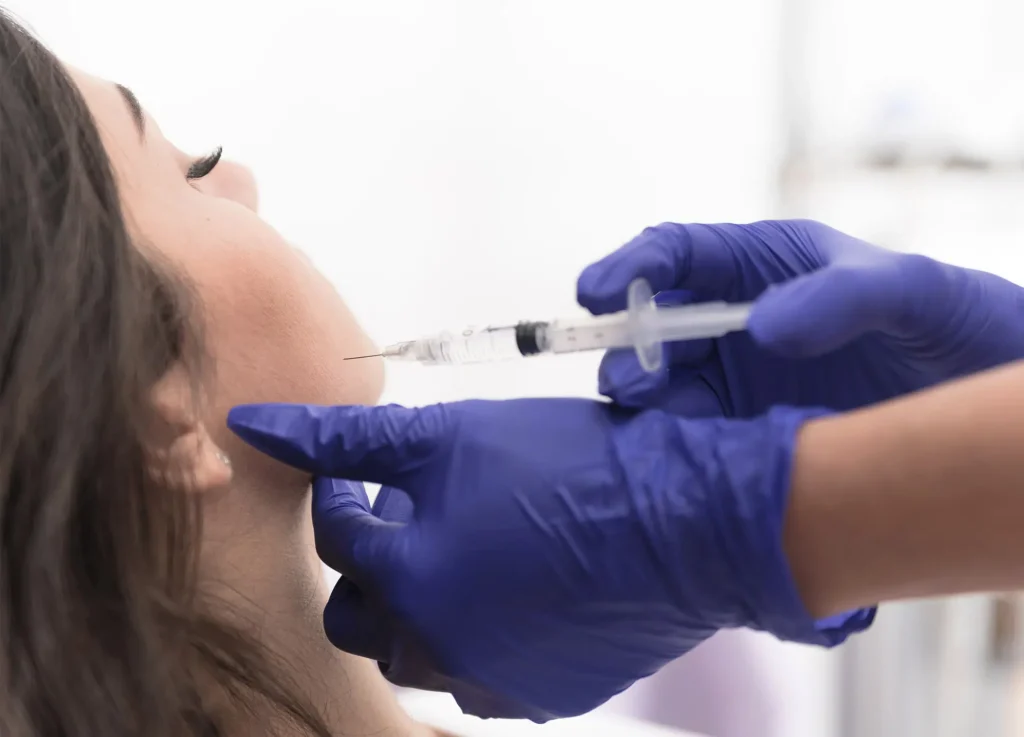Botox may be best known for its wrinkle-smoothing effects on the forehead and crow’s-feet, but the injectable neurotoxin has plenty of other applications. One of the very first uses of botulinum toxin was to treat blepharospasm; today, it’s also a common treatment for those who suffer from migraines, cerebral palsy spasms, and excessive sweating. And one injection site gaining popularity blurs the line between medicine and aesthetics, offering benefits for both arenas. Masseter Botox (aka Botox injections in the jaw) can be used to treat TMJ or slim the jawline—and many people rely on it for both.
Ahead, doctors weigh in on how masseter Botox works, who’s a good candidate, and whether you should be concerned about the strange side effects you may have heard about on social media.
How does masseter Botox work?
The same muscle-relaxing principles of any type of Botox injections apply here. “Botox prevents muscle contractions, which also causes the muscle to shrink over time,” explains Dr. Jessie Cheung, a board-certified dermatologist in Willowbrook, Illinois. Think of it as losing a six-pack after not exercising for a while—if that muscle is weakened, it will also diminish in size, adds Dr. Konstantin Vasyukevich, a New York City board-certified facial plastic surgeon. That first part—a relaxed, weakened masseter, the muscle that runs from the temple to the lower jaw—is what helps to improve common symptoms of TMJ, reducing jaw tension and pain and decreasing grinding and clenching, says Dr. Y. Claire Chang, a board-certified dermatologist in New York City. The shrinkage is what contributes to a slimmer lower face and a less square jawline.
It bears mentioning that sometimes Botox needs to be injected not only into the masseter but also the temporalis muscle. These are two of the four “chewing” muscles, and both are responsible for bruxism, the technical term for grinding or clenching, says Dr. Cheung. “Clenchers tend to have enlarged temporalis muscles. Grinders tend to have enlarged masseters and hollowed temples because the chronic tension accelerates fat loss in this area,” she explains. Either way, injecting into either or both areas contributes to a slimmer-looking face.
How much Botox is used in the masseter?
The short answer: a lot. It differs based on the patient and size of their muscles, but Dr. Chang says she typically uses 50 to 60 units in total. Similarly, Dr. Cheung says that on average, she injects 30 units per side. Dr. Vasyukevich says he typically starts with 25 units per side but often goes up to 50 units per side.
How long does masseter Botox last?
While Botox tends to have approximately a three- to four-month lifespan, the higher dose used in the masseters means that the injections in this area can last up to six months, according to Dr. Cheung.
Who is a good masseter Botox candidate?
“Those with severe TMJ symptoms or teeth grinding may be candidates, especially if lifestyle changes and night guards have been ineffective,” says Dr. Chang. It helps to treat the root cause of the bruxism, adds Dr. Cheung; while a mouth guard protects your teeth, it doesn’t stop the grinding and clenching. If that’s not an issue for you and your motivation is purely cosmetic, it’s a good option for those with a wider or square jawline who want it to have more a V shape.
Who isn’t a good candidate?
Along with the usual Botox caveats—it’s a no-go for anyone who is pregnant, is breastfeeding, or has neuromuscular disorders—those with significant skin laxity should proceed with caution, says Dr. Chang. “Reducing the volume around the angles of the jaw can loosen up the skin of the lower face and end up resulting in a less defined jawline,” adds Dr. Vasyukevich. He also notes that sometimes fullness around the side of the face can be a result of overdeveloped parotid (salivary) glands—in which case, reducing the size of the masseter won’t help achieve a slimmer look.
Can masseter Botox have negative side effects?
Search masseter Botox on TikTok, and you’ll find plenty of videos praising the results… and plenty warning of bizarre side effects, including worsened jaw clenching, a lopsided smile, and an inability to chew. So what gives? According to Dr. Chang, bruising, mild soreness, and tightness are typically common, due to the needle injections, but usually dissipate within one to two weeks. Similarly, “fatigue or difficulty chewing hard or tough foods is also common for the first few weeks because the masseter muscle has been weakened. Over time, other jaw muscles compensate and chewing returns to normal,” she says. If you feel like your clenching has gotten worse post-injections, it may be that only your masseter was injected and you also need injections in the temporalis muscle, notes Dr. Cheung.
All that being said, “proper masseter Botox should not affect your smile. If it’s injected too far forward or too superficially, it will hit the risorius muscle, which is responsible for lifting the smile,” explains Dr. Cheung. The result: a droopy or uneven grin. Unfortunately, the only remedy here is time. The Botox will wear off eventually, and in the meantime, working your smile muscles (in other words, smiling as much as possible), can help it wear off faster, she says.
What not to do after masseter Botox
Taking a few super simple precautions after masseter Botox injections can ensure you end up with the best possible results, as well as help mitigate the potential for any unwanted side effects. First, wait at least 12 hours before any kind of strenuous cardio workout, such as spinning or intense running; the increased blood flow can, theoretically, move the neurotoxin to unintended areas before it can completely bind to the targeted muscle. You’ll also want to keep your head upright—no napping or downward dog-ing—for at least four hours after your appointment. And finally, wait about 12 hours to put any kind of pressure on or around your jaw muscles, be that via a facial massage or with a tool such as a jade roller. Again, this type of pressure can cause unwanted diffusion, or spread, of the Botox.
Source: Realself







